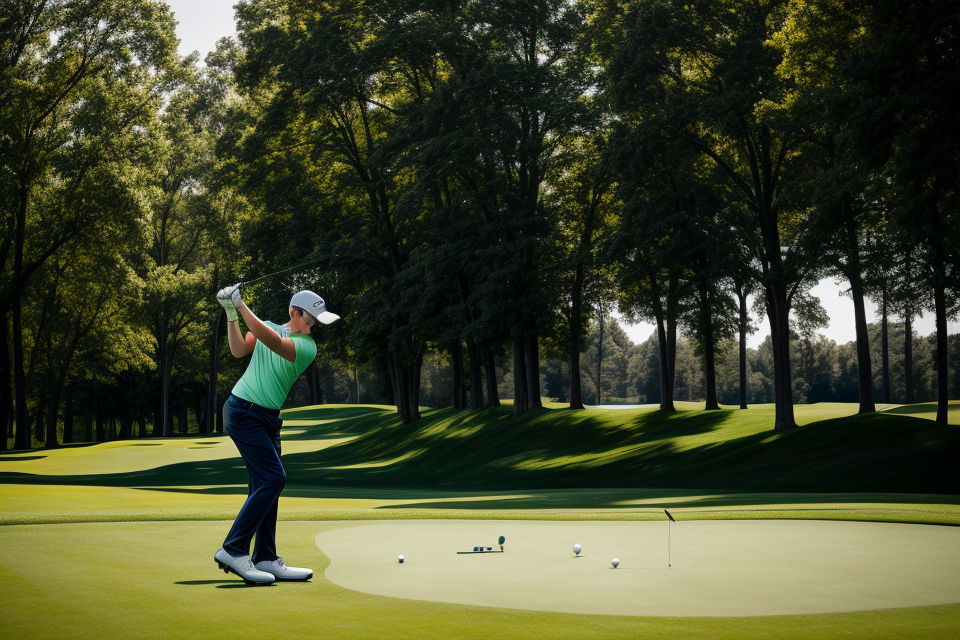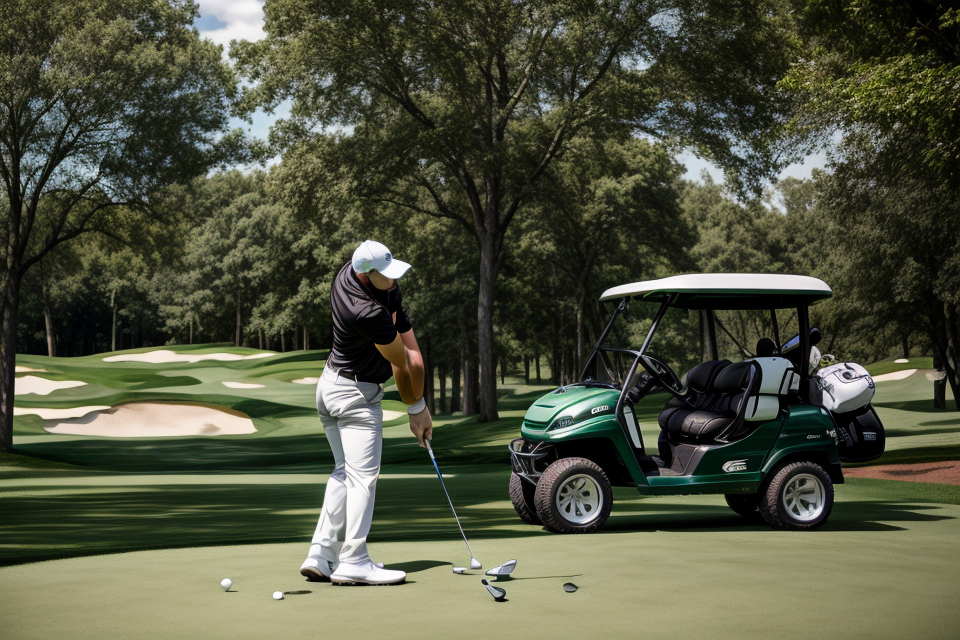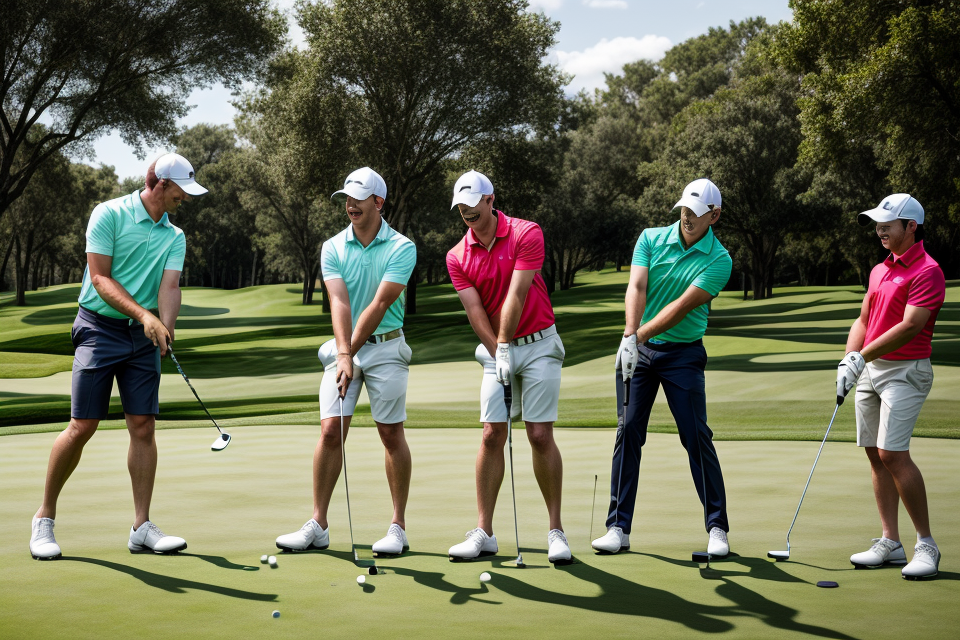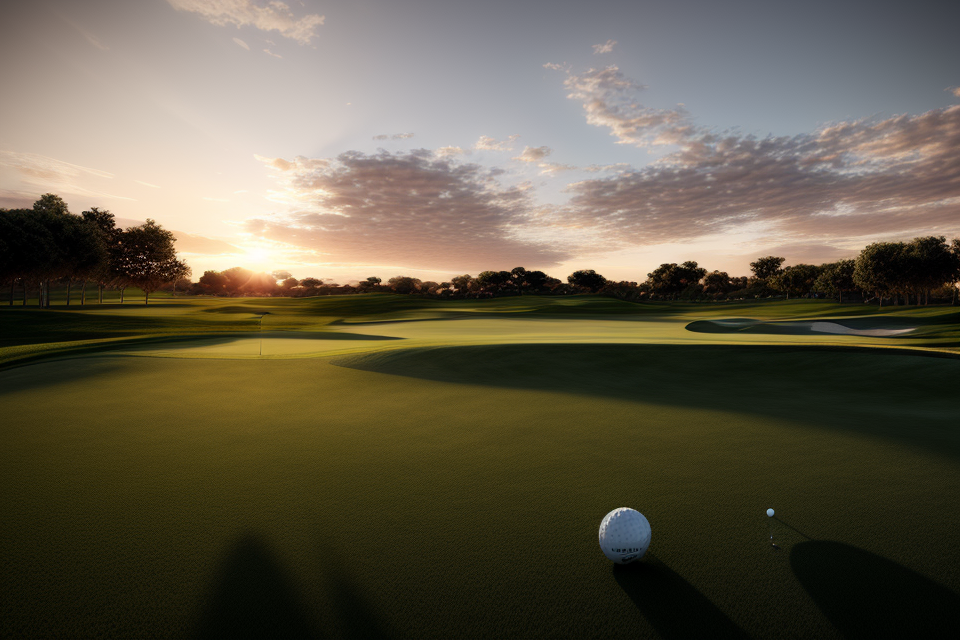
Golf is a sport that requires precision and accuracy. Aiming properly is a crucial aspect of the game that can make or break your score. Many golfers struggle with aiming correctly, leading to frustration and missed shots. However, with the right techniques and mindset, mastering the swing and aiming in golf can be achieved. In this article, we will explore the proper way to aim in golf, including tips on how to improve your aim and ultimately, your game. Whether you’re a beginner or an experienced golfer, this guide will provide you with valuable insights to help you achieve your goals on the green. So, grip your club, take a deep breath, and let’s get started on mastering the swing and aiming in golf!
Understanding the Fundamentals of Aiming in Golf
The Importance of Alignment
In golf, proper alignment is crucial to hitting the ball accurately and effectively. This is because the alignment of the body, ball, and target can greatly impact the direction and trajectory of the shot.
Body Alignment
Body alignment refers to the position of the body in relation to the intended target. A golfer’s body should be square to the target, with the feet, knees, hips, and shoulders all facing in the same direction. This alignment helps to ensure that the golfer can make a smooth, powerful swing and hit the ball in the desired direction.
Ball Position
The position of the ball can also affect the direction of the shot. The ball should be placed in the center of the stance, directly between the feet. This position allows the golfer to make a solid, consistent contact with the ball and hit it in the intended direction.
Target Alignment
Target alignment refers to the golfer’s focus on the intended target. A golfer should choose a specific point on the target and focus on it throughout the swing. This helps to ensure that the shot is aimed correctly and that the golfer can make a smooth, powerful swing.
Overall, proper alignment is essential to hitting the ball accurately and effectively in golf. By paying attention to body alignment, ball position, and target alignment, golfers can improve their aim and shoot lower scores.
The Mental Aspect of Aiming
Aiming in golf is not just about physically lining up your shot; it also involves a strong mental game. The way you approach the shot mentally can have a significant impact on your ability to aim accurately and ultimately hit the ball where you want it to go. Here are some key aspects of the mental game to consider when it comes to aiming in golf:
- Visualization techniques: Visualization is a powerful tool in golf, and it can help you improve your aim. By closing your eyes and mentally “rehearsing” the shot, you can improve your ability to visualize the correct aim and execute the shot more accurately.
- Focus and concentration: Golf requires a high level of focus and concentration, especially when it comes to aiming. You need to be able to block out distractions and maintain your focus on the target. This can be achieved through techniques such as deep breathing, mental imagery, and mindfulness.
- Trusting your swing: Trust is a crucial component of the mental game in golf. If you don’t trust your swing, it can be difficult to aim accurately and hit the ball with confidence. To build trust in your swing, it’s important to practice regularly and work on developing a consistent, repeatable swing. This will help you develop a sense of confidence in your ability to hit the ball where you want it to go.
Selecting the Right Target
Factors to Consider
When it comes to selecting the right target in golf, there are several factors that you need to consider. These factors can greatly impact your shot and ultimately determine whether you make a birdie or a bogey. Here are some of the most important factors to consider when selecting your target in golf:
- Course layout: The layout of the course can play a big role in determining your target. For example, if you’re playing a par-5 with a narrow fairway, you may want to aim for the center of the fairway to give yourself the best chance of reaching the green in regulation. On the other hand, if you’re playing a short par-3 with a large green, you may want to aim for a specific area of the green to avoid hazards or other obstacles.
- Wind conditions: The wind can also play a significant role in determining your target. If you’re playing in a strong crosswind, you may need to aim for a specific location on the fairway to account for the wind’s impact on your shot. Similarly, if you’re playing downwind, you may want to aim for a location that will take advantage of the wind to help you reach the green.
- Terrain and hazards: The terrain and hazards on the course can also impact your target selection. For example, if you’re playing a hole with a steep slope off the fairway, you may want to aim for a specific location on the fairway to avoid rolling into a hazard or rough. Similarly, if you’re playing a hole with a pond or other water hazard, you may want to aim for the safer side of the hazard to avoid ending up in the water.
Overall, selecting the right target in golf requires a careful consideration of all these factors. By taking the time to assess the course layout, wind conditions, and terrain and hazards, you can improve your aim and increase your chances of making a successful shot.
Choosing a Specific Aiming Point
Selecting the right target is crucial to hitting a successful shot in golf. When it comes to choosing a specific aiming point, there are several factors to consider.
One important factor is to choose a target that is at the right distance from you. The distance will depend on the specific hole and the club you are using. For example, if you are using a driver, your aiming point will be further down the fairway than if you were using a wedge.
Another important factor is to choose a target that is at the right angle. This means taking into account the slope and undulation of the green. For example, if the green slopes from left to right, you may need to aim slightly to the right of the pin to account for the slope.
Additionally, it is important to consider the position of the pin on the green. If the pin is located in the back of the green, you may need to aim for a specific area of the green to avoid missing the green entirely. On the other hand, if the pin is located in the front of the green, you may need to aim for a specific area to avoid going over the green.
Overall, choosing a specific aiming point requires taking into account several factors, including distance, angle, and pin position. By considering these factors, you can increase your chances of hitting a successful shot in golf.
Improving Your Aim
Physical Techniques
Using Aiming Devices
One physical technique for improving your aim in golf is to use aiming devices. These devices can help you align your body and clubface properly, ensuring that your shots are more accurate. Examples of aiming devices include laser rangefinders, aiming rods, and alignment sticks. These tools can help you establish a consistent aim point and improve your overall accuracy.
Practicing Aim
Another physical technique for improving your aim in golf is to practice aiming. This involves spending time on the driving range or practice green, focusing on your aim rather than just hitting shots. You can set up various targets or markers to help you develop a better sense of your aim point. Additionally, you can practice using different clubs and shot types, such as draws or fades, to improve your accuracy.
Slowing Down Your Swing
Slowing down your swing can also help you improve your aim in golf. When you swing too quickly, it can be difficult to maintain proper alignment and control your shot trajectory. By taking a slower, more controlled swing, you can better maintain your aim point and hit more accurate shots. This technique may require some practice, as it can be challenging to slow down your swing without sacrificing power. However, with time and repetition, you can develop a more controlled and accurate swing.
Mental Techniques
Visualization Exercises
Visualization exercises involve mentally rehearsing the perfect golf shot. This technique is used by many top golfers to improve their performance on the course. The process involves closing your eyes and imagining yourself taking a perfect swing, from the backswing to the follow-through. This can help you develop a clear mental picture of what a successful shot looks like, making it easier to replicate in real life.
Positive Self-Talk
Positive self-talk is a technique that involves using positive affirmations to improve your mental state and focus during a golf game. By telling yourself things like “I can do this” or “I am a great golfer,” you can boost your confidence and reduce anxiety. This can help you stay focused and perform better on the course.
Managing Distractions
Managing distractions is a mental technique that involves learning to tune out distractions and stay focused on the task at hand. This can be especially helpful when playing in a busy or noisy environment. By learning to ignore distractions, you can stay focused on your shot and improve your performance.
One effective way to manage distractions is to use a mantra. A mantra is a word or phrase that you repeat to yourself to help you stay focused. For example, you might repeat the word “focus” to yourself as you take a shot, reminding yourself to stay focused on the task at hand.
Another effective way to manage distractions is to use visualization techniques. By visualizing yourself taking a successful shot, you can help yourself stay focused and calm under pressure. This can help you perform better on the course, even when faced with distractions or other challenges.
Avoiding Common Aiming Mistakes
Misaligned Body
When it comes to aiming in golf, a misaligned body can be one of the most common mistakes that golfers make. A misaligned body can cause a golfer’s aim to be off, resulting in shots that miss the target.
Causes of Misaligned Body
There are several causes of a misaligned body in golf, including:
- Poor posture: A golfer’s posture can have a significant impact on their aim. If a golfer’s posture is poor, it can cause their body to be misaligned, resulting in shots that miss the target.
- Weak core muscles: The core muscles are essential for maintaining proper alignment in golf. If a golfer’s core muscles are weak, it can cause their body to be misaligned, resulting in shots that miss the target.
- Lack of balance: Balance is crucial in golf. If a golfer lacks balance, it can cause their body to be misaligned, resulting in shots that miss the target.
Corrections for Misaligned Body
To correct a misaligned body in golf, golfers can try the following:
- Improve posture: Golfers can improve their posture by standing up straight, keeping their shoulders relaxed, and avoiding leaning to one side.
- Strengthen core muscles: Golfers can strengthen their core muscles by performing exercises such as planks, sit-ups, and Russian twists.
- Improve balance: Golfers can improve their balance by practicing on uneven surfaces, wearing appropriate shoes, and avoiding standing on uneven terrain.
Incorporating a Warm-Up Routine
To prevent a misaligned body in golf, golfers can incorporate a warm-up routine before each round. A warm-up routine can help to improve posture, strengthen core muscles, and improve balance. Golfers can incorporate stretches, light exercises, and practice swings into their warm-up routine to prepare for the round.
In conclusion, a misaligned body can be a common mistake in golf, but it can be corrected by improving posture, strengthening core muscles, and improving balance. Incorporating a warm-up routine before each round can also help to prevent a misaligned body and improve overall performance on the golf course.
Rushing the Swing
Rushing the swing is a common mistake that can have a significant impact on the accuracy of a golfer’s aim. It occurs when a golfer tries to complete the swing too quickly, often due to nerves or the desire to hit the ball harder. This can lead to a loss of control over the club and the ball, resulting in poor aim and direction.
One of the main causes of rushing the swing is a lack of focus on the process of the swing itself. Golfers who are overly focused on the end result, such as hitting the ball into the hole, may neglect to pay attention to the technical aspects of the swing, such as the position of the club and the body. This can lead to a rushed and uncontrolled swing, with the golfer losing sight of their intended aim.
To correct this mistake, golfers should focus on the process of the swing, paying close attention to the position of the club and the body at each stage of the swing. This includes taking the time to properly set up the shot, using the correct grip and stance, and maintaining a smooth and controlled motion throughout the swing. By focusing on the process, golfers can avoid rushing the swing and maintain better control over their aim.
Overthinking
Causes and corrections
Overthinking is a common issue that can lead to incorrect aiming in golf. This occurs when a golfer spends too much time thinking about the mechanics of their swing rather than focusing on the target. This can cause a golfer to tense up and make compensations that throw off their aim.
One cause of overthinking is a lack of trust in one’s swing. Golfers who are unsure of their ability to hit the ball accurately may spend too much time thinking about their swing rather than focusing on the target. This can lead to a cycle of tension and inaccuracy that is difficult to break.
Another cause of overthinking is a lack of familiarity with the course. Golfers who are unfamiliar with a course may spend too much time trying to navigate the course rather than focusing on the target. This can lead to a loss of focus and poor aim.
Simplifying the aiming process
To avoid overthinking, golfers should simplify the aiming process. This can be done by focusing on the target and using a simple aiming technique. One technique is to pick a spot on the target and use it as a reference point throughout the swing. This can help to eliminate distractions and keep the focus on the target.
Another technique is to use a natural aiming point. This is a point on the target that is aligned with the golfer’s body and swing path. Using a natural aiming point can help to reduce the mental effort required to aim and can lead to more accurate shots.
Additionally, golfers can use visualization techniques to simplify the aiming process. This can include visualizing the shot and the target before the swing and using mental imagery to maintain focus during the swing. Visualization can help to reduce the mental effort required to aim and can lead to more accurate shots.
Overall, simplifying the aiming process is key to avoiding overthinking in golf. By focusing on the target and using simple aiming techniques, golfers can reduce distractions and improve their accuracy on the course.
FAQs
1. What is the proper way to aim in golf?
The proper way to aim in golf is to position the golf club so that the ball is aimed at the desired target. This means that the player should align their body, arms, and club in a straight line, with the clubface pointing directly at the intended destination.
2. How can I improve my aim in golf?
Improving your aim in golf requires practice and patience. One effective technique is to use a target on the golf course, such as a flagstick or a small object, and focus on hitting the ball towards that target. It’s also important to pay attention to your body position and make sure you are aligned properly with the target. Additionally, practicing your swing on a regular basis can help you develop better aim and control over your shots.
3. What are some common mistakes to avoid when aiming in golf?
Common mistakes to avoid when aiming in golf include:
* Lifting your head up during the swing
* Not paying attention to your body position and alignment
* Swinging too fast or too slow
* Letting your hands control the club too much
* Focusing too much on the target instead of the process of the swing
By avoiding these mistakes, you can improve your aim and overall performance on the golf course.
4. How do I know if my aim is correct in golf?
To know if your aim is correct in golf, you should use a target on the golf course, such as a flagstick or a small object, and compare your shots to the intended destination. If the majority of your shots are hitting the target or landing close to it, then your aim is likely correct. However, if your shots are consistently missing the target, you may need to adjust your aim or focus on improving your swing.
5. Can changing my grip or stance affect my aim in golf?
Yes, changing your grip or stance can affect your aim in golf. For example, if you change your grip to a more comfortable or natural position, it may affect the alignment of your body and club, which can impact your aim. Similarly, changing your stance can also affect your body position and alignment, which can impact your aim. It’s important to find a comfortable and effective grip and stance that allows you to maintain proper alignment and aim.


